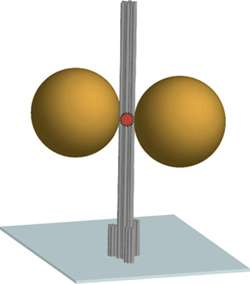July 22, 2013 report
Researchers use DNA origami technique to build nanoantennas with docking sites

A team of researchers working at Germany's Technische Universität Braunschweig has succeeded in using a previously known DNA origami construction technique to build a nanoantenna with a docking site. First published in the journal Science, the paper written by the team has now been made publicly available for open access.
DNA scaffolding has in recent years been developed to allow for orienting single molecules in useful ways. One of those has resulted in the creation of what is known as DNA origami—where DNA strands are folded in certain ways to create three dimensional nano-sized objects. In this new effort, the team used the technique to place two gold particles astride a protein pillar creating a hotspot that brightens fluorescent signals in zeptoliter volumes. The result is a tall pillar held erect on a flat surface using DNA strands that can be used to hold single molecules.
The flat surface was made of a biotin-binding protein. The pillar (also made of a protein) is 220 nm long and 15 nm in diameter. It was held in place by strands of DNA. Two gold nanoparticles (80 to 100nm diameter) were suspended (again by DNA strands) on each side of the pillar (23 nm apart) and were used as an antenna to focus light on a hotspot between them. A fluorescent dye was placed into that hotspot and was used as an optically active source—its purpose was to report the degree of fluorescent enhancement—which was the purpose of the antenna.
The antenna the team built demonstrates one way that DNA origami is being used to build a scaffold for holding molecules in three-dimensional space. The hope is that it will lead to what is known as atomically precise manufacturing—where nano-sized components could be manufactured in bulk. An antenna such as the one built in this new effort, allows for focusing light to a very small volume allowing for investigating molecules in a way that is up to 100 times more precise than conventional lenses. What's most interesting about the antenna, of course, is that it's held together by DNA strands that have been "programmed" to spontaneously wrap themselves around the antenna in just the right way to hold everything in place.
The researchers next plan to conduct experiments to see if DNA origami structures can also be used to allow for more precise control of chemical reactions.
More information: Science 338, 506 (2012); DOI: 10.1126/science.1228638
Journal information: Science
© 2013 Phys.org





















